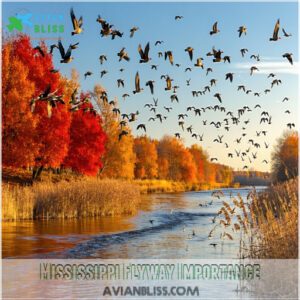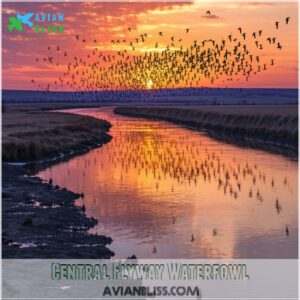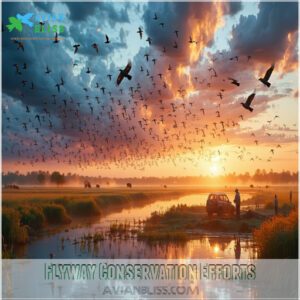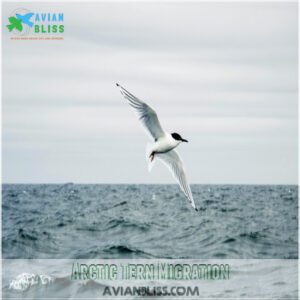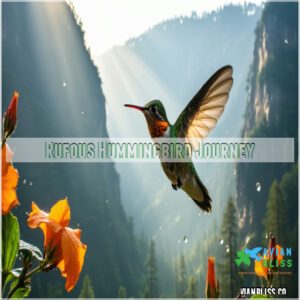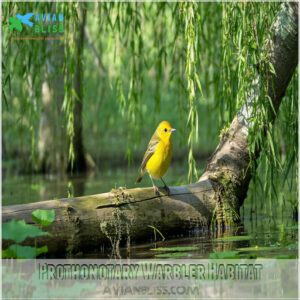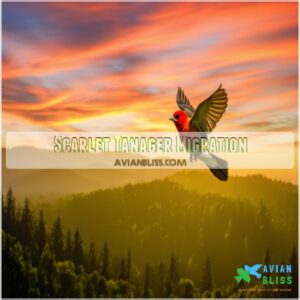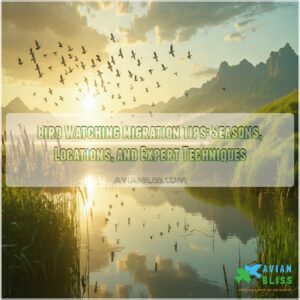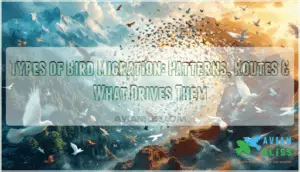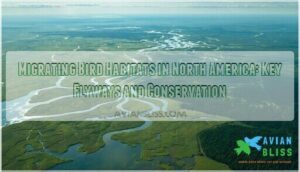This site is supported by our readers. We may earn a commission, at no cost to you, if you purchase through links.
 The best bird migration routes, or flyways, are nature’s highways, guiding thousands of birds across continents.
The best bird migration routes, or flyways, are nature’s highways, guiding thousands of birds across continents.
In North America, the Atlantic Flyway offers coastal marshes and wetlands, perfect for shorebirds needing a pitstop.
The Mississippi Flyway is like a bustling avian freeway, following rivers from the Arctic to the Gulf of Mexico.
The Central Flyway is a dream for waterfowl, hosting Sandhill Cranes and Snowy Plovers as they traverse the Great Plains.
Meanwhile, the Pacific Flyway hugs the coast, supporting over 8 million shorebirds annually.
These routes are essential for survival, connecting habitats—because even birds need a reliable GPS!
Table Of Contents
- Key Takeaways
- Bird Migration Routes
- Flyway Conservation Efforts
- Migratory Bird Species
- Bird Corridors and Habitats
- Tracking Migration Patterns
- Frequently Asked Questions (FAQs)
- Which state has the most migratory birds?
- What is the most interesting bird migration?
- What bird has the longest migration route?
- Which flyway has the most birds?
- How do birds navigate during bad weather?
- What role do predators play in migration?
- How do birds prepare physically for migration?
- What impact does pollution have on migration?
- Why do some birds migrate in flocks?
- Conclusion
Key Takeaways
- You’ll find that the Atlantic, Pacific, Mississippi, and Central Flyways are vital migration routes, connecting breeding grounds to winter habitats across continents.
- Birds rely on conserved stopover habitats like marshes, wetlands, and forests for rest and refueling during their long journeys.
- Advanced tracking tools like GPS telemetry and radio devices uncover precise migration patterns, boosting conservation efforts.
- Protecting flyways isn’t just about birds—it preserves ecosystems, biodiversity, and the balance of natural habitats.
Bird Migration Routes
Bird migration routes are like nature’s highways, connecting breeding grounds to winter habitats across vast distances.
You’ll find that these flyways, such as the Atlantic, Pacific, Mississippi, and Central, are essential pathways for millions of birds undertaking seasonal journeys, which can be thought of as traveling on nature’s highways.
Atlantic Flyway Characteristics
The Atlantic Flyway is a bird highway stretching from Greenland to South America.
It’s perfect for migratory bird species, thanks to its diverse coastal habitats and reliable bird stopovers.
Audubon’s Atlantic Flyway conservation efforts focus on mitigating human impact on this essential ecosystem.
- Bird migration routes include marshes, wetlands, and forests.
- Smooth bird migration patterns minimize obstacles.
- Important for species like shorebirds.
- Offers food, rest, and safety during journeys.
Mississippi Flyway Importance
The Mississippi Flyway is a bustling highway for bird migration routes, stretching from the Arctic to the Gulf of Mexico.
It follows iconic river ecosystems like the Mississippi and Missouri, offering critical bird habitats.
Nearly half of North America’s bird species use this essential migration route.
With millions of migratory bird species relying on its wetlands and valleys, this flyway showcases incredible Flyway Ecology while supporting Waterbird Conservation and diverse Migration Patterns.
Central Flyway Waterfowl
While other flyways have their charm, the Central Flyway‘s an absolute powerhouse, hosting over half of North America’s migratory waterfowl.
You’ll find this impressive bird migration route stretching from the Canadian Arctic right down to the Gulf of Mexico.
Here’s what makes the Central Flyway special:
- It’s a major highway for Sandhill Cranes, with hundreds of thousands gathering in Nebraska’s Sandhills
- The route follows the Great Plains‘ natural corridor
- Multiple tributaries branch off, creating a network of paths
- You’ll spot diverse species like Snowy Plovers and Canvasbacks
- Regular surveys track waterfowl movement patterns
Pacific Flyway Shorebirds
While waterfowl fill the skies of the Central Flyway, the Pacific Coast Migration paints an equally impressive picture.
You’ll find over 8 million shorebirds following ancient bird migration routes along the Pacific Flyway each year.
These determined travelers make key Flyway Stopovers at places like Willapa Bay, where Shorebird Conservation efforts through the Pacific Flyway Survey Network help track their incredible journeys from Arctic nests to South American beaches.
Flyway Conservation Efforts
Three essential conservation strategies protect our key bird migration flyways today.
You’ll find dedicated teams working on habitat restoration along coastal areas and key stopover sites, ensuring birds have safe places to rest and refuel.
Modern bird conservation efforts today address threats like habitat destruction and climate change.
The Americas Flyway initiative’s targeting 30 essential migration spots, focusing on wildlife preservation in grasslands, wetlands, and shorelines where ecological balance is critical.
Conservation efforts don’t stop at borders – they’re connecting habitats across continents to maintain these natural highways in the sky.
Bird migration conservation requires protecting both breeding grounds and winter homes, especially as climate change shifts traditional patterns.
Flyway protection isn’t just about saving birds – it’s about preserving entire ecosystems.
By maintaining these critical pathways, we’re helping countless species complete their remarkable journeys while safeguarding biodiversity for future generations.
Migratory Bird Species
You’ll find amazing birds like Arctic Terns that fly over 44,000 miles each year, making the longest migration of any animal on Earth.
From tiny Rufous Hummingbirds traveling 3,000 miles to Scarlet Tanagers crossing continents, these remarkable creatures show us just how far wings can take you.
Arctic Tern Migration
You’ll be amazed by the Arctic Tern, nature’s ultimate marathoner, covering an astounding 59,650 miles in its yearly migration from England to Antarctica.
Regarding migration patterns, here’s what makes these migratory birds extraordinary:
- They hold the record for longest annual migration, flying twice Earth’s circumference
- Their bird migration routes follow select pathways for conservation
- Spring migration averages 472 miles daily
- Arctic breeding grounds connect to Antarctic waters in a remarkable 80,000 km round trip
The provided information highlights the exceptional migratory abilities of the Arctic Tern, showcasing its remarkable endurance and navigational capabilities.
Rufous Hummingbird Journey
These tiny feathered travelers pack quite a punch in North American bird migration.
Your Rufous Hummingbird follows a unique loop pattern, traveling north along the Pacific Flyway and south through the Rockies.
You can explore Rufous hummingbird migration products related to their fascinating journey.
You’ll find these remarkable migratory birds covering up to 4,000 miles from Mexico to Alaska, tracing their bird migration routes with precision despite weighing less than two pennies.
Their avian navigation skills help them master this marathon journey.
Prothonotary Warbler Habitat
Deep within Mississippi’s riparian forests, you’ll find the golden swamp jewels – Prothonotary Warblers – making their homes.
These migratory birds thrive in moist bottomland forests and permanent wetlands, where they’ve adapted to life among eastern cottonwood and black willow trees.
Bird sanctuaries focus on wetland conservation and habitat restoration, as these warblers need dead snags for nesting and rely heavily on the shrub layer for foraging .
Scarlet Tanager Migration
Gliding through the skies like flames in motion, Scarlet Tanagers navigate complex migration routes between North American forests and South America.
Their close relative, the Western Tanager, shares similar migratory habits, often overlapping ranges.
You’ll find these striking birds making strategic flyway stopovers in Texas and New Mexico during their seasonal movements.
Their unique migration patterns showcase remarkable bird navigation skills.
Learn about western tanager facts and their fascinating behaviors.
- Males transform from brilliant red to olive-yellow during fall migration
- They often travel solo or in small groups along bird migration routes
- Tracking studies reveal they use distinct paths for spring and fall journeys
- Ecuador and Peru serve as key tanager habitat during winter months
Bird Corridors and Habitats
You’ll find that bird corridors act like nature’s highways, connecting different habitats through mountain ranges, river courses, and protected areas that give birds safe passage during their long journeys.
These corridors are especially important when you’re looking at developed areas, where they provide essential links between fragmented landscapes that birds need for survival.
Natural Habitat Preservation
Moving beyond individual species, let’s look at how you can support habitat preservation.
Modern conservation efforts focus on creating bird-friendly spaces in both cities and wild areas.
You’ll find innovative ecosystem management techniques protecting these essential stopovers for migratory birds.
| Habitat Type | Conservation Method | Community Impact |
|---|---|---|
| Urban Parks | Native plantings | Local biodiversity |
| Wetlands | Water management | Ecosystem balance |
| Forest Edge | Buffer zones | Wildlife protection |
| Grasslands | Controlled burns | Species recovery |
| Coastal Areas | Invasive removal | Natural restoration |
Bird Corridor Linkages
Increasingly, bird corridors serve as nature’s highways, connecting essential habitats through landscape linkages.
You’ll find these migration pathways taking various forms – from creek-based flyways that support thriving bird populations to stepping stone corridors linking isolated wetlands.
Bird passage through these routes isn’t random; corridor ecology shows that quality habitat connectivity, whether through woodland strips or waterways, strengthens the survival of migratory species across multiple migration routes.
Managed Area Conservation
Protected areas like wildlife refuges play a huge role in habitat conservation along bird migration routes.
Through Ecosystem Management and Habitat Restoration, these spaces support safe stopovers for migratory birds.
Protecting 458 migratory bird species, as detailed on this bird migration habitat conservation webpage, is a critical focus of these efforts.
Conservation Strategies can also include creating bird corridors within managed areas, linking critical habitats seamlessly.
Your backyard might even be part of this network—pretty amazing, right?
Fragmented Landscape Challenges
Small, scattered habitats can feel like obstacle courses for migratory birds.
Landscape fragmentation creates wildlife barriers, squeezing bird corridors and disrupting ecosystems.
Birds lose essential resting stops, while mismatched habitat timing affects migration routes.
Habitat loss means fewer safe zones, causing energy-draining detours.
Conservation strategies, like reconnecting fragmented areas, give migratory birds a lifeline, keeping key bird migration routes intact, which is crucial for maintaining ecosystems.
Tracking Migration Patterns
You can uncover incredible details about bird migration using modern tracking tools like GPS and radio telemetry.
These technologies let researchers map journeys with amazing accuracy, showing just how far and fast birds travel, utilizing radio telemetry.
GPS Satellite Telemetry
GPS satellite telemetry revolutionizes bird migration tracking, giving precise data on migration patterns and locations.
Whether monitoring behavior or studying stopover habitats, satellite tracking delivers unmatched location accuracy.
It’s like having a bird’s-eye map, helping scientists protect migratory routes and guarantee safe bird migration through critical habitats, utilizing telemetry devices.
Doppler Satellite Telemetry
With Doppler satellite telemetry, you’ve got a powerful tool for bird migration tracking.
By measuring signal strength and frequency shifts, this system pinpoints bird migration routes with impressive data accuracy.
It’s like giving satellites a sixth sense to track birds over vast migration distances.
These telemetry systems provide insights into movement, helping conserve habitats and support long-distance bird monitoring efforts, utilizing bird migration tracking and impressive data accuracy to inform their work.
Light-Level Geolocators
Ever wonder how scientists track bird migration routes without GPS?
Light-level geolocators offer a clever solution.
These tiny devices use sunrise and sunset data to pinpoint locations, though clock drift and weather can cause location errors.
Researchers can purchase light level geolocator products online.
Here’s why they matter:
- Map bird movement and timing.
- Track migratory birds’ key habitats.
- Aid conservation with data analysis.
- Study remote migrations effectively.
The ability to track bird migrations is crucial for understanding their behavior and for conservation efforts, making light-level geolocators a valuable tool in this field.
Automated Radio Telemetry
While light-level geolocators offer big-picture insights, automated radio telemetry steps up for pinpoint precision.
By using tiny radio tags and telemetry systems, this method tracks bird movement seamlessly along migratory routes.
Scientists study bird behavior migration patterns to understand these incredible journeys.
Think of receivers as bird monitoring “listeners,” capturing signals for detailed data analysis.
It’s a game-changer for decoding bird migration routes and conserving habitats with unmatched accuracy, making pinpoint precision a crucial aspect of the process.
Frequently Asked Questions (FAQs)
Which state has the most migratory birds?
Texas boasts the most migratory birds in the U.S., thanks to its diverse habitats and key location along the Central Flyway.
Over 600 species pass through, making it a birdwatcher’s paradise during migration seasons.
What is the most interesting bird migration?
Majestic migrations mesmerize many, but the Arctic Tern’s epic 44,000-mile journey steals the spotlight.
It chases endless summers from pole to pole, proving that even tiny birds can achieve tremendous travels with unwavering determination.
What bird has the longest migration route?
The Arctic Tern takes the prize for the longest migration route, traveling over 44,000 miles yearly between the Arctic and Antarctica.
It’s like a nonstop road trip, covering two summers and endless adventure.
Which flyway has the most birds?
Think of flyways as superhighways in the sky.
The Mississippi Flyway hosts the most birds, channeling millions of ducks, geese, and shorebirds along its vast rivers—nature’s perfect rest stops for weary travelers.
How do birds navigate during bad weather?
Birds handle bad weather by lowering altitude, using landmarks like coastlines or rivers, and relying on instinctual navigation.
They pause during extreme storms, finding shelter to wait it out—nature’s survival instincts are always their guide.
What role do predators play in migration?
Predators influence bird migration by shaping routes, timing, and behaviors.
You’ll notice birds often travel in flocks or at night to reduce risk.
Migration demands careful balancing—avoiding predators while conserving energy across long distances, which is crucial for migration.
How do birds prepare physically for migration?
Like marathon runners carb-loading before a race, birds bulk up by gorging on high-energy foods.
They store fat as fuel, molt feathers for peak performance, and fine-tune their muscles for the long journey ahead.
What impact does pollution have on migration?
Pollution messes with migratory routes by contaminating water and food sources birds rely on, damaging habitats, and making stopovers unsafe.
It’s like throwing roadblocks onto their paths, leaving them struggling to refuel and survive, which can be described as a pollution issue.
Why do some birds migrate in flocks?
Nearly 90% of migratory birds travel in flocks for safety and efficiency.
Flying together reduces energy use, improves navigation, and deters predators—kind of like a natural carpool with built-in security and GPS.
Conclusion
Just like migratory birds following their ancient flyways, you can explore the best bird migration routes with a new appreciation for their importance.
These flyways—such as the Atlantic, Mississippi, Central, and Pacific—are essential lifelines for diverse bird species.
They showcase nature’s instinctive brilliance and the need for conservation.
By understanding these pathways, you’re not just marveling at wildlife; you’re also helping protect key habitats.
So, why not get out there and witness these remarkable journeys firsthand?
- https://www.birdful.org/what-are-the-4-flyways-in-the-us/
- https://abcbirds.org/blog/north-american-bird-flyways/
- https://birdwatchingenthusiast.com/migration-hotspots-birds-north-america-birdwatchers-guide/
- https://www.britannica.com/science/migration-animal/Birds
- https://www.birdlife.org/globalflyways/


